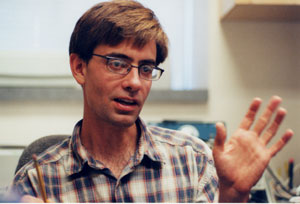|
HOME | SEARCH | ARCHIVE |
|
Fly expert wins MacArthur ‘genius’ award
![]()
By Robert Sanders, Public Affairs
| |  Integrative Biology Professor Michael Dickinson is one of 23 new MacArthur award winners. He was named for his research on the aerodynamics of flying insects. Peg Skorpinski photo |
31 October 2001
|
An expert on the aerodynamics of flying insects, Professor of Integrative Biology Michael Dickinson has won one of this year’s prestigious MacArthur “genius” awards. The professor in the College of Letters & Science was among 23 new MacArthur Fellows announced last week by The John D. and Catherine T. MacArthur Foundation. Each of the winners will receive $500,000 over five years to spend as they wish. The MacArthur Fellowships, often called “genius” awards, are given each year to creative individuals “who provide the imagination and fresh ideas that can improve people’s lives and bring about movement on important issues,” according to Jonathan Fanton, president of the foundation. Dickinson, 38, was the last of the new MacArthur Fellows to be notified this year and “the hardest award winner to reach in the foundation’s history,” the scientist said. Off backpacking with a friend along the remote Na Pali coast of Hawaii, Dickinson was not carrying a cell phone or pager. The foundation was finally able to get word to him by calling his hiking companion. Thrilled upon hearing the news, Dickinson said, “It’s all kind of surreal. I figure that for the rest of my career, everyone in the lab is going to start each sentence, ‘if you’re such a genius, why can’t you…’” Dickinson, who has a Ph.D. in zoology from the University of Washington, refers to himself as a neuroethologist. He studies the nerve and muscle connections that allow flying insects to maneuver so expertly that they are among the most versatile and sophisticated of all flying animals. The principles he uncovers are being applied to the development of tiny flying robots that have potential uses in search and rescue, environmental monitoring and remote sensing. “Flies are the most accomplished fliers on the planet in terms of aerodynamics,” he said. “They can do things no other animal can, like land on ceilings or inclined surfaces. And they are especially deft at takeoffs and landings — their skill far exceeds that of any other insect or bird.” To study insect flight, he has built some amazing contraptions. One is a virtual reality “flight arena” for flies, in which he displays various moving scenes to tethered flies and records their wing motions. “Fly-o-rama” is like a small circus tent in which he records in three dimensions how a fly moves in response to various stimuli. Variations on these themes include a “rock-and-roll arena” in which he studies fly responses to mechanical stimuli, and “smell-o-vision,” where visual stimulation is combined with food odors, such as vinegar. He has also constructed 10-inch-long models of fruit fly wings — 100 times normal size — and immersed them in a vat of mineral oil to study the currents and vortexes set up by their wing motion. This model, dubbed “Robofly,” has enabled him to break down flies’ rapid wing-flapping into three distinct wing motions that not only allow insects to stay airborne, but also let them steer and execute amazing acrobatic maneuvers. These mechanisms, much different from the mechanisms used by birds and airplanes, seem to be common to most insects and, perhaps, even to the hummingbird. “This robotic fly enables you to resolve questions about how insects manage to fly that are impossible to address otherwise,” said George Lauder, a professor of organismic and evolutionary biology at Harvard University and an expert on how fish swim. “Michael is the only one I know who has quantified the forces on a moving biological appendage.” In other experiments, Dickinson and his laboratory colleagues dissect fly flight muscles and nerves to tease out their interconnections or to record electrical signals from them. “There is nobody in the world who has the range of expertise, from neurophysiological approaches through fluid mechanics, that Michael has,” Lauder said. Ron Fearing, a Berkeley professor of electrical engineering, leads a team now building a micromechanical flying insect based on the principles that Dickinson has discovered. “It is Michael’s aerodynamic breakthrough that is going to make our micromechanical flying insect possible,” Fearing said.
Home | Search | Archive | About | Contact | More News
Copyright 2000, The Regents of the University of California.
Produced and maintained by the Office of Public Affairs at UC Berkeley.
Comments? E-mail berkeleyan@pa.urel.berkeley.edu.